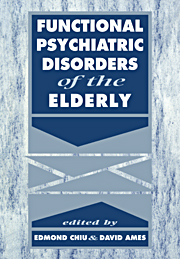Book contents
- Frontmatter
- Contents
- List of contributors
- Preface
- Introduction – A personal note
- Acknowledgement
- Part 1 Classification
- 1 Functional psychiatric disorders in ICD 10
- 2 The classification of functional psychiatric disorders in DSM-III-R and DSM-IV
- Part 2 General epidemiology
- Part 3 Neuroses
- Part 4 Affective disorders
- Part 5 Psychosexual disorders
- Part 6 Substance use and abuse
- Part 7 Schizophrenia and related psychoses
- Part 8 Psychological, biological and medical issues
- Part 9 Treatment methods
- Part 10 Conclusion
- Index
2 - The classification of functional psychiatric disorders in DSM-III-R and DSM-IV
from Part 1 - Classification
Published online by Cambridge University Press: 13 November 2009
- Frontmatter
- Contents
- List of contributors
- Preface
- Introduction – A personal note
- Acknowledgement
- Part 1 Classification
- 1 Functional psychiatric disorders in ICD 10
- 2 The classification of functional psychiatric disorders in DSM-III-R and DSM-IV
- Part 2 General epidemiology
- Part 3 Neuroses
- Part 4 Affective disorders
- Part 5 Psychosexual disorders
- Part 6 Substance use and abuse
- Part 7 Schizophrenia and related psychoses
- Part 8 Psychological, biological and medical issues
- Part 9 Treatment methods
- Part 10 Conclusion
- Index
Summary
Introduction
Classification systems have varied over the centuries. Their differences reflect the changing purposes of classification and the varying ethos of the time periods in which they are developed. The DSM-III-R (American Psychiatric Association, 1987) and DSM-IV (American Psychiatric Association, 1991), structured upon the approach developed by Emil Kraepelin (1915) at the end of the nineteenth century, were devised to provide reliable, operationalized criteria for the diagnosis of psychiatric disorder. The issue of age differences is rarely explicitly addressed in either set of criteria but the texts of both books do make reference to age-related issues. This chapter will review the classification of the functional psychiatric conditions common in later life in these two sets of criteria.
As will be evident in the discussion that follows, many of the strengths and weaknesses of DSM-III-R and DSM-IV reflect the basic assumptions Kraepelin made a century ago. Three of these are highlighted in this chapter.
Kraepelin adopted the syndromic approach of Thomas Sydenham (McHugh & Slavney, 1973). He and the DSM-III-R cluster psychiatric signs and symptoms into recognizable syndromes that are assumed to be diseases. However, because no underlying bodily abnormality has been found in most cases of functional psychiatric disorder, these categories should remain tentative until valid markers are identified.
[…]
- Type
- Chapter
- Information
- Functional Psychiatric Disorders of the Elderly , pp. 16 - 28Publisher: Cambridge University PressPrint publication year: 1994



